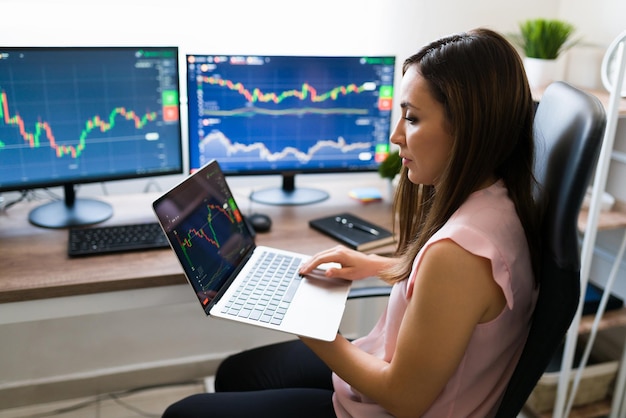It is quite tough to build up a trading account in a volatile market environment. The new traders mostly fail to achieve consistency, risk management, or avoid the psychological pitfalls. Unless and until proper strategies are prepared for them, they mostly reap back the profits or blow up the accounts.

Best practices developed by experienced traders and risk managers at SMB Capital, one of the leading proprietary trading firms, have been developed to boost returns but still assure long-term success.
In this article, we are going to dive into the top three strategies that effective traders have used to responsibly grow their trading accounts in 2024. These methods have been refined through years of use and show risk management, consistency, and personal well-being – all key components. Let’s get started!
4 Tips Avoid Common Trading Pitfalls
1. Protect Your Green Days: Consistency is King
Protect your green days is one of the most critical trading lessons: make sure when you are profitable on a particular day, you stay profitable and don’t throw the profit away by overtrading or taking unnecessary risks.
Why does that matter?
- Volatility vs. Consistency: The market can be highly volatile and provides huge opportunities when you are not prepared. However, as a matter of fact, the market often presents “average days” rather than massive trend days. Traders realizing this understand that not every day is the time to go for homers.
- The Math of Small Wins: Imagine the math of consistently making $100 per day for 20 trading days. That results in a $2,000 month. If you can increase that to $1,000 a day, then you have scaled your account to $20,000 a month. That’s the power of small, consistent wins.
How to Implement
- Daily Review: Conduct pre-market risk review before every session, reviewing the day’s opportunity set. Do you ask yourself, “Is it a singles and doubles day, or am I trying for home runs?”
- Stop Trading After Green: Most newbies blow their money on “normal” days by overtrading or chasing gains after their first few green trades. Adopt a rule to stop trading if the market does not offer more after your first few green trades.
By constantly protecting your green days, you are securing not just your profits but building discipline and creating a groundwork in scaling your account responsibly.
2. Per Symbol Risk Limits: Avoid Overexposure on One Trade
The other hallmark of building the account in 2024 is setting per symbol risk limits. This should prevent you from overexposing the same stock or asset, which can deteriorate into expensive losses quickly.
Why it matters
- Emotional Attachment: The users get attached to particular shares or security items after a few successful trades. This makes them overconfident and overtrade one symbol, thus losing big time in money.
- Capital Protection: You will be able to reduce the chance of losing all your profits or account balance in one trade by allocating a certain percentage of your daily stop loss to each symbol.
How It Works
- Daily Risk Allocation Example: Using an example, if your daily stop loss is $1,000, then you would allocate no more than 30-50% of that limit to any one symbol in order to keep yourself diversified and remove catastrophic losses for a single trade.
- Walk Away After a Loss: This means that if you reach the risk you had established per symbol, stop trading in that symbol for the rest of the day. It’s pretty tempting to “win it back,” but this usually ends up resulting in more loss and trading emotionally.
However, limiting risk on a per-symbol basis ensures that when even one trade gets blown, it does not blow your entire day, and thus you can continue to trade with clear headedness and decrease emotional decisions.
3. Recharge and Refocus Outside of Trading:
The third, often neglected, strategy is keeping life outside of the marketplace. Trading can be mentally exhausting, and without the right outlets, a trader puts herself or himself at risk of burnout or mistakes based on her or his emotional state.

Why It Matters
- Burnout and Fatigue: Those who spend all their time in front of screens frequently find that mental acuity deteriorates over time, leading to poor decision making and trading by emotion.
- Psychological Resilience: By keeping life in perspective outside of trading helps bring you into the desk each day refreshed, focused, and ready to perform.
How To Implement
- Hobbies and socializing: Most successful traders have hobbies, such as traveling, mingling, or going to the gym. Dan G is one of the top performers at SMB Capital. He travels the world and trades. The breaks provide a mental reset, and he returns to be far more effective in the screen.
- Healthy lifestyle choices, from physical exercise or some creative hobbies to spending more time with loved ones, may be a very important outlet to staying grounded and seeing that you do not become your trading.
By focusing on a balanced lifestyle, you’re not only preserving your mental health but also perfecting your focus and decision-making abilities in the market. This is one of the very important ingredients to building your trading account long term.
4. Use a Give Back Rule: Capturing Big Winning Days
The give back rule is actually protecting your profits on the isolated days when you are trading above your mean winning performance. When you find yourself up a lot, it may feel like you want to really go and get some more; however, the give back rule ensures that you do not lose it all.
Why It Matters

- Protecting Psychology: There’s nothing quite as demoralizing as being up thousands of dollars in a single day, only to completely blow that through by the end of the session. It can really take a toll on one’s confidence going into the next day.
- Locking in Profits: A trailing stop protects your gains in a stock. The give back rule works similarly, but for your overall daily profits.
How to Implement:
- Introduce a Profit Tolerance: Assuming your good days average comes in at $1,000, engage the give back rule when you hit 1.5 times that amount, or $1,500. From there, install a stop loss so you don’t give back more than 30-35% of that high watermark.
- Stick to the Plan: Upon that give back rule, cease trading for the day or drastically reduce your size. This will protect the marginally above-average days and avoid emotional trades when you are on a winning streak.
With this very effective give back rule, you don’t allow such infrequently occurring profitable days add extra risk to your account but instead deliver gains.
Conclusion
For one to grow the trading account in 2024, it demands more than just skill in trading execution; it requires well-calculated risk management. Here are three core strategies: protect your green days, use per symbol risk limits, and balance outside of trading. With such measures, you’ll keep a good foundation for sustainable growth. On implementing the give back rule, you’ll protect your most profit-making days and avoid those psychological strains of taking back hard-earned gains.
Continue on your journey without ever forgetting that it’s not about how much you can make per day but rather about how much you can protect and consistently grow.